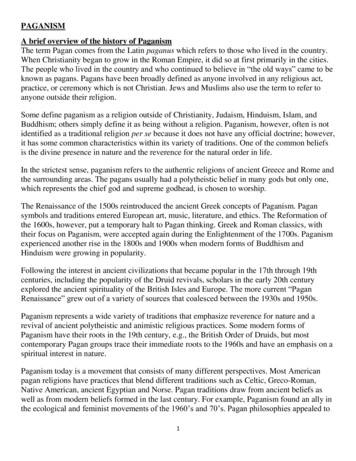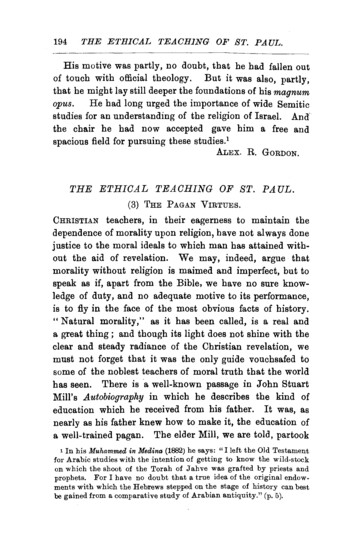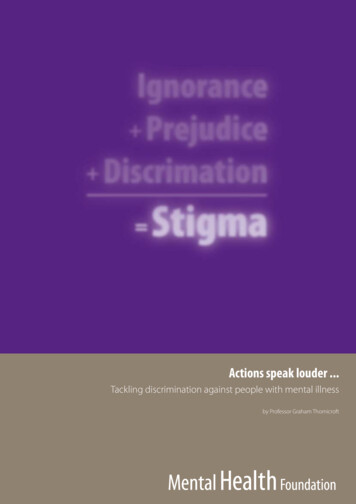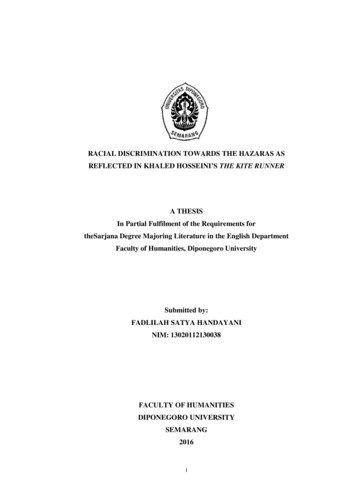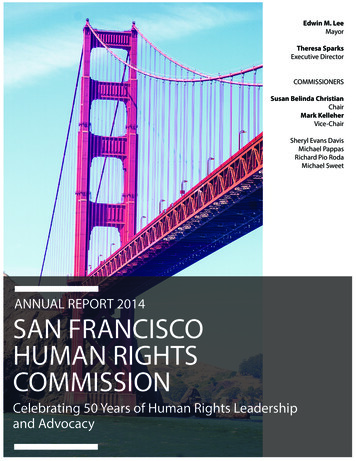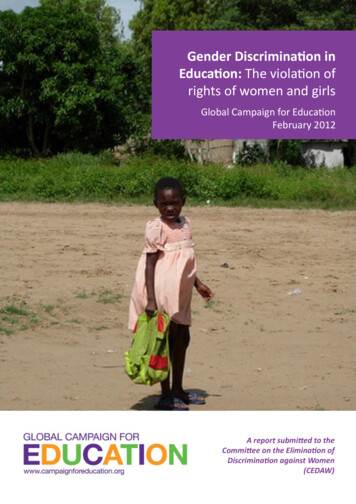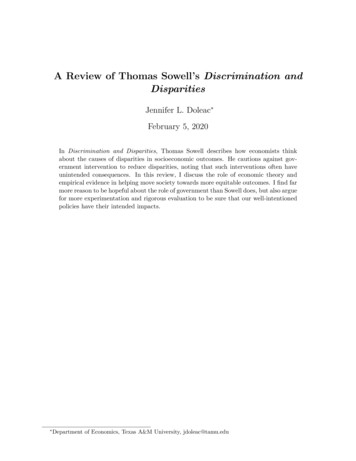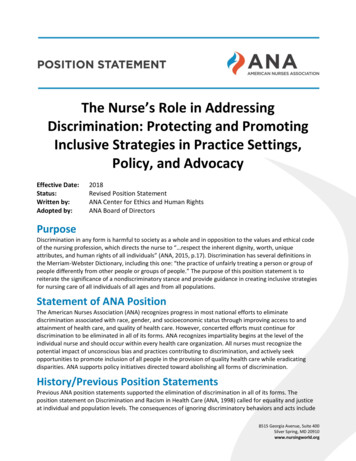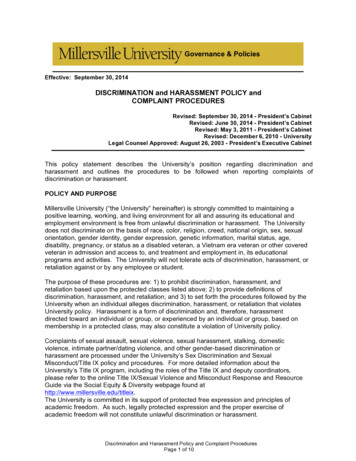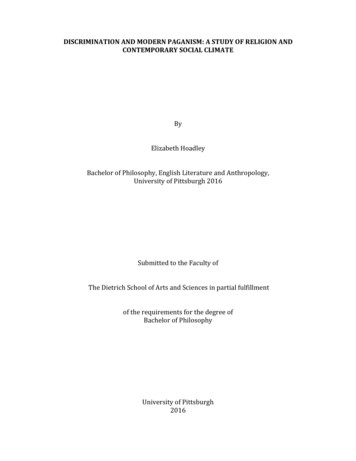
Transcription
DISCRIMINATION AND MODERN PAGANISM: A STUDY OF RELIGION ANDCONTEMPORARY SOCIAL CLIMATEByElizabeth HoadleyBachelor of Philosophy, English Literature and Anthropology,University of Pittsburgh 2016Submitted to the Faculty ofThe Dietrich School of Arts and Sciences in partial fulfillmentof the requirements for the degree ofBachelor of PhilosophyUniversity of Pittsburgh2016
UNIVERSITY OF PITTSBURGHDIETRICH SCHOOL OF ARTS AND SCIENCESThis thesis was presentedbyElizabeth HoadleyIt was defended onMay 17, 2016and approved byDr. Michael Bobick, Postdoctoral Fellow, Department of AnthropologyDr. Amy Murray Twyning, Lecturer, Department of EnglishDr. S. Zoreh KermaniThesis Director: Dr. Hannah Johnson, Associate Professor, Department of Englishii
DISCRIMINATION AND MODERN PAGANISM: A STUDY OF RELIGION ANDCONTEMPORARY SOCIAL CLIMATEElizabeth Hoadley, BPhilUniversity of Pittsburgh, 2016This work investigates attitudes of religious discrimination against Paganism andhow the faith is lived as a culture. It closely examines how discriminatory attitudes againstPaganism are translated into actions and how they have affect Pagan lives on an individualbasis. This project also investigates the origins of discriminatory attitudes for non-Pagans,in order to better understand them. The research problem includes two basic parts:distinguishing discriminative actions and attitudes, and observing their effects on Pagans’daily lives. The cycle of action and information involved in discrimination against Pagans isdiscussed in detail, including an analysis of the defense mechanisms employed by Pagans tomitigate the adverse effects of discrimination in their lives. The goal of this research is toadd to current understandings of religious discrimination and how it can greatly influencePagan practice and culture. The use of the results of this research will include but not belimited to: further studies on the cultural power of religious discrimination, the formationof greater public understanding of nontraditional religions and how they are affected bymodern social climates, and the addition of a seldom heard voice into currentconversations surrounding religious tensions in the modern world.iii
TABLE OF CONTENTSCHAPTER ONE. 11.01.1INTRODUCTION . 11.2COMMUNITY SCOPE NATIONALLY AND REGIONALLY. 71.3RESEARCHING DISCRIMINATION . 101.4PAGAN ORIGINS AND PRACTICE . 141.4.11.5Historical Origins . 14RECONSTRUCTING A DEFINITION. 181.5.1Animism . 181.5.2Individual and Community . 201.5.3Magic . 221.5.4Ritual . 241.5.5A Working Definition. 262.0CHAPTER TWO .292.1SCHOLARLY ROOTS OF THE FIELD . 292.2DEFINITION AND SYNTHESIS (1980-1995): . 312.3CONSOLIDATION AND COMMUNITY (1995-2005): . 352.4ANALYSIS AND EVOLUTION (2005 – Present): . 392.5Previous Work on Discrimination . 423.03.1CHAPTER THREE .48DEALING WITH DIFFERENCE: THE NON-PAGAN VIEW . 48iv
3.1.1Conceptualizing the Unfamiliar . 483.1.2Translating Fictional Imagery into Reality . 493.1.3“Witchcraft? Like Cauldrons and Flying Broomsticks and Pointy Hatsand Stuff?”. 523.1.4“I’m Pretty Sure It’s Devil Worship.” . 563.1.5“They’re Just a Bunch of Weirdos.” . 603.2MASKING DISCRIMINATION . 623.2.1Performances and How to Spot Them . 633.2.2My Own “Liars” . 68CHAPTER FOUR .734.04.1UNCOVERING THE CYCLE OF DISCRIMINATION . 734.1.1Interviewing and Effects. 754.1.2 Creating a Cycle of Ignorance . 764.2THE PAGAN PERSPECTIVE . 794.2.1 Lisa and Tara . 794.2.2Matt. 814.2.3Janet . 854.35.0A COMMUNUAL RESPONSE . 88CONCLUSION .90APPENDIX A .95APPENDIX B .95BIBLIOGRAPHY .97v
vi
1.01.1CHAPTER ONEINTRODUCTIONIn 1994, three teenage boys from a small town in Tennessee were convicted of the firstdegree murder of three children based on false accusations of participation in a satanicritual. The main suspect, Damien Echols, had an interest in Wicca and unbeknownst to him,his religious curiosity would be the downfall of his entire case. Soon after the mangledbodies of the three young boys were found, rumors began circulating that the killings mighthave been the work of devil worshipers. Even before receiving any information on the case,the West Memphis Police Department assigned the case number 93-05-0 666 to the file, thelast three digits a number historically associated with the devil, (Echols v. State, 1996). Twodays after finding the bodies, investigators interviewed the “troubled local teenager,”Damien Echols. Damien “wrote dark poems, wore long hair, had a tattoo on his upper arm,and was a self-described Wiccan.”1 With a history of psychological problems such asdepression and aggression, Damien presented the investigators with an easy target. Whensearching his home, investigators testified at trial that they found “eleven black t-shirts andthe book Never on a Broomstick.”2 While owning a lot of black t-shirts and a (ratherinformative and well-rounded) book on the history and origin of Wicca does not seem,today, to prove his participation in a ritual murder of three young boys, this interest inWicca was the pinnacle of the prosecution’s case. In addition to the book, investigators also12This is a direct quote from the investigative report included in the Echols v. State (1996) case file.ibid.1
obtained Damien’s private notebook full of musings on the religion from which Damien wasasked to read during his trial.In the investigative report published on May 10th, 1993 outlining Damien’sstatements to the police, he echoes the thoughts and experiences of many other Wiccans.Damien came across a community online and met a person “who he considered to be apriestess.” 3 He described his religion as a “white witch group,” that believed “there was aGoddess and not a God,” and that worked together towards “a divine light” (Echols v. State).Despite testifying repeatedly that he “was not a Satanist,” and “didn’t believe in humansacrifice,” Damien Echols was convicted of murdering all three children during a satanicritual and was sentenced to death that same year at the age of 18 (Echols v. State). Aftermany years of arbitration Echols has recently been released from prison, but the scars ofsuch a grave misunderstanding remain. Echols, who was wrongly understood as a Satanist,was in reality just a troubled boy who had an interest in Paganism, a nature-based religionthat believes in doing no harm and the significance of the cycles of life (Linder).This case represents the consequences that may arise from misinformation which isthe focus of this study. Although throughout history, elements of animal sacrifice have beenincluded in some traditions, the nature of the religions included within the Pagan label isnot in any way centered on things such as devil worship and human sacrifice. In fact, theWiccan Rede, or the Wiccan moral code, requires that a witch harm none, and Wiccansfirmly believe that whatever they put out into the world, positive or negative, will comeback to them in life three-fold; thus making it very important to act with positivity towards3Even the language within this report gives way to the pre-existing attitudes that the prosecution held.Phrases like “who he considered to be,” show their lack of faith in the validity of his statement andsuspicion surrounding the religion itself.2
others (Walker). Wiccans regard the Rede as an age-old tradition passed down orally, thecontents of which is the code by which all Wiccans identify themselves and their values(Walker). Paganism, like most other religions, has its main focus on personal growth, andthe creation of a community. They seek to enlighten themselves with the aspects of abetter, more whole self, which they find in nature. Paganism, a precise definition of whichwill be discussed further on, is an umbrella term encompassing a variety of nature-basedreligions including Wicca, the definitions of each just as deep and tangled as history itself.The word Paganism functions much like the term Christianity: under the umbrella ofChristianity and its various denominations and sects, one finds highly variable beliefs andpractices that are all united by a small set of core, universal beliefs. The same is true forPaganism. Even though the reaches of paganism are wide and diverse, each sect celebratessuch diversity in a respectful way and all identify as a larger community as well asindividual branches. For someone to be sentenced to death simply because members of lawenforcement were not familiar with Wicca and did not inform themselves depicts the levelof ignorance surrounding Paganism and the consequences that can come from suchmisunderstanding. It seems acutely human to be carried away by what is exciting anddramatic as can be seen in non-Pagans’ definition of words such as witchcraft, whichrelates to the practice of Wicca and other Pagan groups but has been redefined by popcultural imagery. What naturally sticks in one’s mind is not the mundane or benign, butrather what is exciting and unfamiliar. This is perhaps the reason why pop cultureunderstandings of witchcraft are quickly attached to Pagan religions. The deep historicaltension and modern cultural spectacle attached to the word Witch, is where thisdiscrimination and misunderstanding grows roots. Noting the importance of such3
influences, my research aims to further investigate the origins and extent of thesepotentially discriminatory attitudes.When introduced to the topic of my research, many in my audience struggle to placethe word Paganism into a context in which it is easily understood. While witch andwitchcraft are terms that are exceedingly familiar within popular culture, Paganism is aword seldom heard in mainstream society. Whether they consider it a dead, ancientreligion, or have been acquainted with the term in a derogatory way through their ownreligious background, all of my informants outside of Pagan culture found it much moredifficult to explain the word Paganism than words like witch and witchcraft. While thelatter two words are inevitably connected in their minds, Paganism, the technical umbrellaterm for a variety of reclaimed ancient religions, is much more unfamiliar to most ofmodern America than the term witch, which is used as an insider designation mainly byWiccans and as a derogatory statement by some non-Pagans. When one thinks of a modernwitch, most people immediately picture some form of devil worship or evildoer—an imagepopularized by films, television, and the media. Unfortunately for Damien Echols, hisoutward appearance of what many labeled as “gothic,” fit this bill perfectly (Linder). Whilethe gothic subculture is unrelated to the actual practice of Paganism entirely, this imagerooted in entertainment is then transferred onto mainstream society’s ideas of the religionof Paganism as the pop culture “witch” is often their only link between understanding andunfamiliarity. The case of the West Memphis Three, for example, is a testament to thenegative stigma that the Wiccan religion receives as a result of this ideological connection.Although the witch-hunts of the past may seem archaic, the sad reality is that evenin America today religiously motivated hate crimes make up about one fifth of all hatecrimes committed (United States Department of Justice). These include violence,4
vandalism, and threats among others. However, in the case of Paganism what seem to bemore detrimental are the less blatant, systemic consequences of misunderstanding andignorance, such as that which brought the death penalty upon Damien Echols in the WestMemphis Three case. Damien was not beaten up by a stranger, nor was his homevandalized, but because the members of law enforcement in charge of his case immediatelywrote off the Wiccan religion as devil worship, the consequences quickly spiraled out ofcontrol. Even beyond the legal and publicly visible realm is an entire level of discriminationthat nearly always goes unreported. The consequences of these circumstances are echoedin the accounts of many of my Pagan informants. One man, for instance, had his Pagan flagtorn completely down by one of his neighbors. While this was indeed an act of vandalismand could be considered a hate crime, what Jeff4, a 50-year-old man from the quietcountryside just outside of Pittsburgh, considered to be more detrimental was the loss ofhis peace of mind and place in the community. Jeff has been a member of the communityfor many years and lives in a fairly rural area that is heavy with Christian churches. Whilehe was aware that his neighbors were Christian, he never imagined that they would go sofar as to walk onto his property and physically vandalize his flag:It was just a nice little flag I picked up at one of the esoteric stores I went to once,and I didn’t think it would offend anyone. It had a pentacle on it, but I’m notembarrassed of that. Satanism inverts the pentacle for evil just like they invert thecross. But one of my neighbors, a middle aged man in the house over, walked up tomy house and tore my flag down. Now, I knew he was a Christian and I could guesswhy he did it, but to actually rip my flag down? That was surprising to me. I feltpretty uncomfortable after that, and I felt like I needed to speak with him about it.When I confronted him about it later, he claimed that my flag had offended him andhe didn’t want his children seeing it. But, I said, the witch decorations he puts uparound Halloween offend me and provides a bad example for his kids too. Thecrappy part is that doesn’t even register to him, even after I talked to him about it.He was still just as angry about his children seeing my flag, and didn’t see anythingwrong with tearing it down. It was like I didn’t even count as a person (P 203).4Pseudonyms have been assigned to all informants in order to protect their anonymity.5
For Jeff, this instance was more than just an act of vandalism on his property but adehumanizing act that made him feel ostracized from his community. While this smallevent was not something that Jeff felt could be reported in a way that would solve anyissues, it is the dehumanizing and demoralizing consequences of the ignorance ofmainstream society that causes much greater detriment to the Pagan community. As Jeffexplained, “I can replace my flag, that wasn’t the issue. The issue was the way it made mefeel unsafe and unwanted in my own community” (P 203). While this feeling is often theresult of hate crimes, what is unique about Paganism is that this ostracization anddiscrimination most often comes from much smaller and covert events that fly under theradar of any real consequence for the discriminator. Many of my Pagan informantsdescribed similar issues resulting from misunderstanding and prejudice associated withPaganism, such as Janet, who was fired from her office job shortly after she started tellingpeople about her religion, or John, whose own family no longer associates with himbecause of his religion (P 236) (P 222). Almost every other informant described the fearthat exists in their lives as a result of hearing the stories of others. I argue that it is thisexact system of information surrounding experiences with the broader community thatleads Pagans to perpetuate the cycle of discrimination by using defense techniques toguard themselves from any possible discomfort.Fear and anxiety leads many Pagans to remain quiet about their beliefs even withtheir closest friends. In this work I argue that while remaining silent decreases their risk ofdiscrimination, it conversely increases the probability that discrimination will continue toexist. Because they are not presenting a clear, visible image of the Pagan population to thecommunity at large, the secrecy and compartmentalization cements in place a feedback6
loop of ignorance and thus discrimination. If the goal of the community is to be respectedand understood, this cycle of ignorance and secrecy cannot continue. However, the easewith which a Pagan is able to guard his or her beliefs makes the alternative—dealing withthe possible consequences that may first come with making their community visible—allthe more unappealing to many. While an African American cannot guard himself againstthe conjectures of a racist, a Pagan has the ability to blend in and remain under the radar ofanyone with strong prejudices against them. This fact leads many members of thecommunity to take precautions in their lives when allowing anyone to know their religion,and thus inadvertently promotes a skewed popular understanding of the scope of thereligion.1.2COMMUNITY SCOPE NATIONALLY AND REGIONALLYAccording to recent Pew Research Center studies on the religious landscape of the U.S.,Paganism makes up .3% of the population. While this number does not seem like a largeportion of the population, it amounts to 956,700 Pagans, given the current U.S. populationof 318.9 million people (Pew Research Center). This lies far beyond what many wouldestimate the population of Pagans to be in the U.S. based on their visibility alone. When onenon-Pagan informant was asked what he would estimate the total population of Paganswithin the U.S. to be, he answered “20,000” (NP 123). This estimate is 2% of the actualpopulation in the U.S. who identify as Pagan or Wiccan. It is not just the secrecy of Pagansthat causes this underestimate, but also the ways in which Pagans practice. Pew estimatesthat nearly 60% of all Pagans choose to practice on their own (Pew Research Center). Beinga solitary practitioner is a popular choice nationally, as the practice of the religion easily7
allows small, individual ceremonies that can be done inside one’s own home. Solitarypractitioners still may function as a part of the broader Pagan community, but performmost religious rituals by themselves. This way, the practitioner is allowed to choose exactlyhow they want to practice and what they want to believe. Because the beliefs encompassedin paganism vary widely, it is often more productive for each member to perform rituals ontheir own. However, 40% of the population is involved in group worship, which although itaccounts for a smaller percentage of the population, is still a notable amount. The truedetriment to visibility, however, is the lack of any established churches. Although thePluralism Project from Harvard University recorded nearly 400 Pagan organizations withinthe U.S., only about one fourth of all of the communities listed actually had a building thatcould be easily identified by an outsider as a place of worship (Eck). For almost one millionfollowers, there are only around 100 estimated centers of worship listed on the websitewith their own buildings. For a large majority of Pagans, their preferred setting for ritualsis outside, in public parks or private land. Many others practice in groups in their leaders’homes. This causes a gap in perceived community size nationally for those who are notinvolved in the Pagan community.This trend is echoed within the smaller sample size of Pennsylvania and withinPittsburgh as well. Pew Research Center projects a similar distribution among religiousaffiliations within Pennsylvania as those presented nationally. A group of .3% of thepopulation residing within Pennsylvania who identify as Pagans would amount to 38,370people, given the most recent state census population record of 12.79 million people (U.S.Census Bureau). Even state-wide, the population of Pagans exceeds the national estimate ofthe non-Pagan informant mentioned above. Again, this underestimate is not shocking, asonly 5 out of the 400 total Pagan religious organizations listed in The Pluralism Project’s8
database are in Pennsylvania, and none are in Pittsburgh (Eck). Based on my own researchand interaction with the Pagan community, this is estimate of the number of religiousorganizations is inaccurate. During my time interacting with the community, I havepersonally come in contact with more than 10 different organizations centered onPaganism just within Pittsburgh and represented among my 38 informants. This leads tothe conclusion that there are perhaps many more religious centers nationally than arelisted on The Pluralism Project’s website. While I have interviewed a total of 38 membersof the Pagan community, I would estimate that there are around 1,000 in the surroundingPittsburgh area, based on attendance at events such as Pagan Pride Festival, and theestimated number of religious groups. However, any estimate of the number of Pagans issubject to inaccuracies as there is a portion of practitioners who do not interact with thecommunity at all and are thus relatively unreachable and unidentifiable.In general, according to The Association of Religion Data Archive (or the ARDA),Pittsburgh’s most popular religion is Catholicism, accounting for 460,672 people out of atotal population of 740,979 in their 2010 report. This lends itself to a moderately religiousatmosphere through the city and its outskirts, and many of my informants have stated thatthey feel Pittsburgh is a very religious city. Out of 25 non-Pagans who were interviewed, allbut one stated that they didn’t feel that Pittsburgh would be a particularly welcoming cityto Paganism, and over half mentioned Pittsburgh’s strong Catholic background. WhenPagans were asked the same question, they were generally more optimistic: on a scale from1 to 10, 25 out of 38 rated the city between a 5 and a 7. This difference is perhaps becausethe non-Pagans are virtually unaware of any sort of Pagan population within Pittsburgh,and therefore are ignorant of the ways in which the Pagan community is alreadyfunctioning easily and peacefully within the city’s limits. In sum, it seems that my9
informants generally feel that Pittsburgh is neither the worst (1) nor the best area (10) ofthe U.S. for a Pagan population in terms of possible discrimination but rather somewhere inthe middle.1.3RESEARCHING DISCRIMINATIONMy project has investigated attitudes of religious discrimination against Paganism, how thefaith is lived as a culture, and how discrimination affects this experience. I have closelyexamined how discriminatory attitudes are experienced and understood by both nonPagans and Pagans alike, as well as how how they have agency over Pagan lives on anindividual basis. The research problem initially involved two basic points of action: first,identifying acts of discrimination that do indeed exist, and then observing the ways inwhich such acts affect Pagans’ daily lives. With the goal being to add to currentunderstandings of religious discrimination and how it can greatly influence Pagan practiceand culture, I expected to see clear, concrete examples of cause and effect moving from thediscrimination exhibited by non-Pagans to the detrimental effects in Pagans lives. What Iinitially had expected to find was a large community of Pagans who were miserablekeeping their religious identities a secret and wished for a way to make themselves knownto the larger community, as well as a strong non-Pagan force of blatant, outwarddiscrimination. However, instead of discovering what I previously thought would be a cutand dry linear path from discrimination to detriment, what I found was that there is adeeply ingrained cycle of feedback between Pagans and non-Pagans: Pagans continue topractice in secret, keeping their community just outside the lines of mainstream culture,and thus non-Pagans continue to be ignorant about the religion due to a lack of accurate10
information presented to them. Simultaneously, instead of finding a very clear and outwardrepresentation of discrimination against Pagans in my research with the non-Pagancommunity, I found that many simply had no idea what the religion actually was, andsubstituted information they thought relevant from earlier life experiences to create aviable sense of understanding for themselves. Moreover, it seems that my Paganinformants do not see keeping their religion a secret as a burden. Secrecy is ingrainedwithin the traditions of Paganism, and doesn’t present any immediate self-perceivedbarriers to their well-being. As secrecy and compartmentalization guard them from anyemotional harm or societal struggle, they have little motivation to stop this behavior.With secrecy and mystery at the center of the religion, it is no wonder that membersoutside of the community have no other understanding of anything even close to the topicbesides what is presented to them in literature and popular culture of witchcraft. Thisignorance and concurrent substitution, I argue, is the root of the majority of thediscriminatory attitudes, and could seemingly be remedied if the Pagan community were tobe more open and visible to its surrounding society. There is comparatively little currentethnographic information on the subject of Paganism compared to most other religions,and nearly half of those who do study it are members of the community themselves. Thisfurther insulates the community into itself. Ethnographers like Sarah Pike and TanyaLuhrmann in their books Earthly Bodies, Magical Selves, and Persuasions of the Witch’s Craftrespectively, provide useful insights into how Paganism functions as a culture andacknowledge that discrimination inevitably exists, yet what is not developed in currentworks is any analysis of the exact consequences of religious discrimination.However, the consistent lack of visible information for the majority of the public is aproblem that must be remedied if the Pagan community hopes to gain respect and11
acceptance as a religion. I address this gap in knowledge by presenting a research projectthat is not rooted solely within the Pagan community. Simply by interviewing non-Pagans,my research allows an outlet for my informants to ask questions after the interview hasbeen concluded, and all 25 asked for more information about the religion and its practices.In total, 38 Pagans and 25 non-Pagans were interviewed over the course of this study, withinterviews ranging from 20 minutes to 1 hour and 40 minutes. The research was conductedusing standard anthropological fieldwork methods, including participant observation andboth formal and informal interviews. Informants were gathered using a snowballtechnique, which involves asking the current interviewee for contact recommendations forfurther interviews. Informal, anonymous on
negative stigma that the Wiccan religion receives as a result of this ideological connection. Although the witch-hunts of the past may seem archaic, the sad reality is that even in America today religiously motivated hate crimes make up about one fifth of all hate crimes committed (United States Department of Justice). These include violence,
